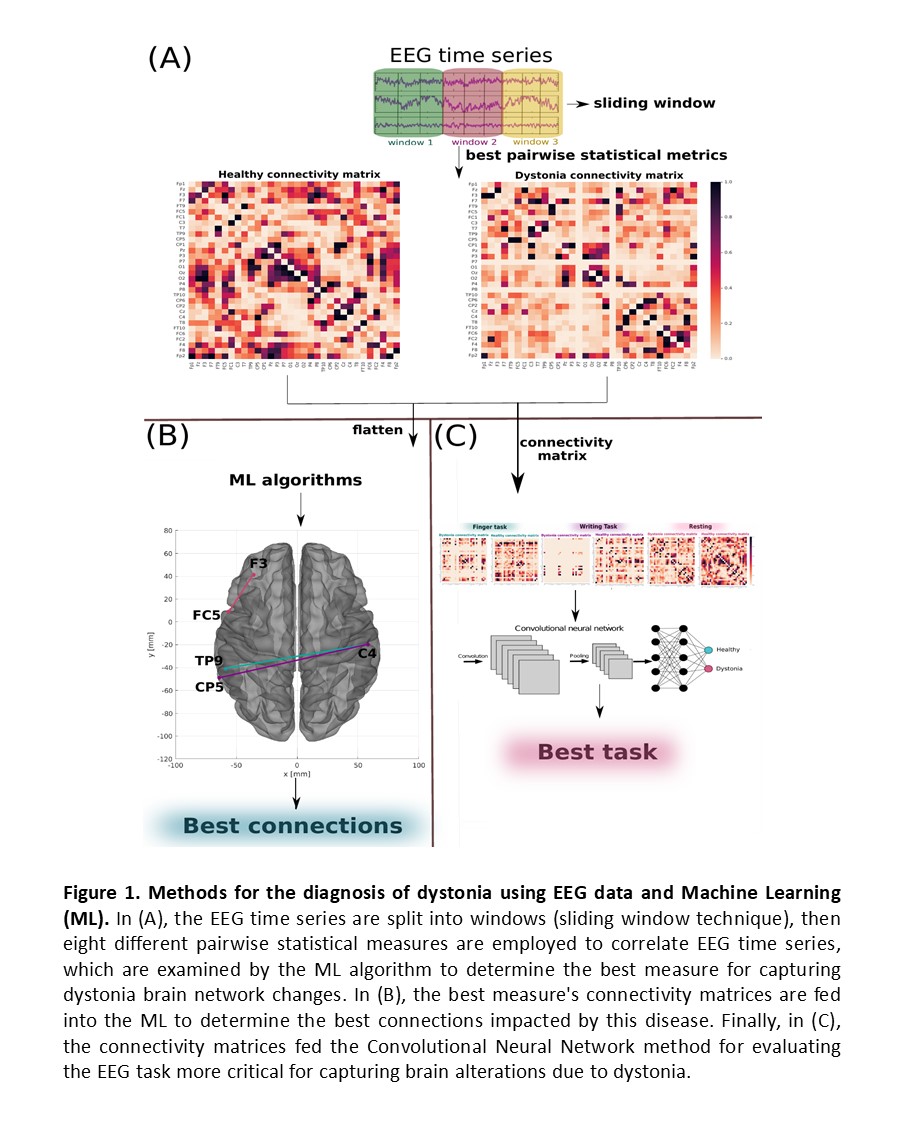Category: Dystonia: Pathophysiology, Imaging
Objective: To apply a novel machine learning (ML) method to EEG data as a tool for the diagnosis of dystonia, providing a medical interpretation and new insights into the disease.
Background: Recent evidence suggests a brain network disorder as the main explanation for the sensorimotor program dysregulation in dystonia. Current diagnostic approaches rely mainly on clinical features and some cases may pose diagnostic challenges with a lack of accuracy. ML techniques can aid in interpreting EEG data by utilizing deep learning networks, particularly convolutional neural networks (CNN) in order to identify a dystonia signature.
Method: EEG from patients with idiopathic right upper limb focal dystonia (n =20) and controls (n=21) during resting-state, writing and finger-tapping were analyzed through a machine learning method. As a data augmentation technique, time series were split into windows of 10 seconds, which were correlated to construct a connectivity matrix through eight distinct pairwise statistical metrics to feed our ML approach, determining the optimum metric for distinguishing brain connectivity patterns between groups. We used the Shapley (SHAP) value method to interpret the results [figure1].
Results: All the classifications resulted in excellent performances with AUC and an accuracy of 99%. The best metric was transfer of entropy. The primary connections related to dystonia were, in order of importance: C4-CP5, F3-FC5, C4-TP9. Regarding CNN, the best EEG task was resting, followed by finger-tapping.
Conclusion: Overall, our methodology is capable of capturing the brain alterations caused by dystonia with a performance superior to that found in the literature, despite the small sample size. The best pairwise statistical measure was transfer entropy, and the best EEG tasks were resting and finger-tapping. Furthermore, our technique outperformed existing research because we employed connectivity matrices, better representing EEG brain changes with less computation cost than raw time series. Using a low-cost technique such as the EEG, this method provides high accuracy in diagnosing focal right upper limb dystonia and can be further explored with other types of dystonia. It can also help to expand the knowledge regarding dystonia’s pathophysiology with the potential to be applied to design brain-machine interfaces to treat this condition. Acknowledgments: FAPESP; CNPq
To cite this abstract in AMA style:
C. Alves, A. Paulo, D. de Faria, J. Sato, S. Azevedo Silva, V. Borges, H. Ferraz, F. Rodrigues, C. Thielemann, P. Carvalho Aguiar. Analysis of functional connectivity using machine learning and deep learning in EEG data from patients with focal dystonia [abstract]. Mov Disord. 2023; 38 (suppl 1). https://www.mdsabstracts.org/abstract/analysis-of-functional-connectivity-using-machine-learning-and-deep-learning-in-eeg-data-from-patients-with-focal-dystonia/. Accessed November 19, 2025.« Back to 2023 International Congress
MDS Abstracts - https://www.mdsabstracts.org/abstract/analysis-of-functional-connectivity-using-machine-learning-and-deep-learning-in-eeg-data-from-patients-with-focal-dystonia/

